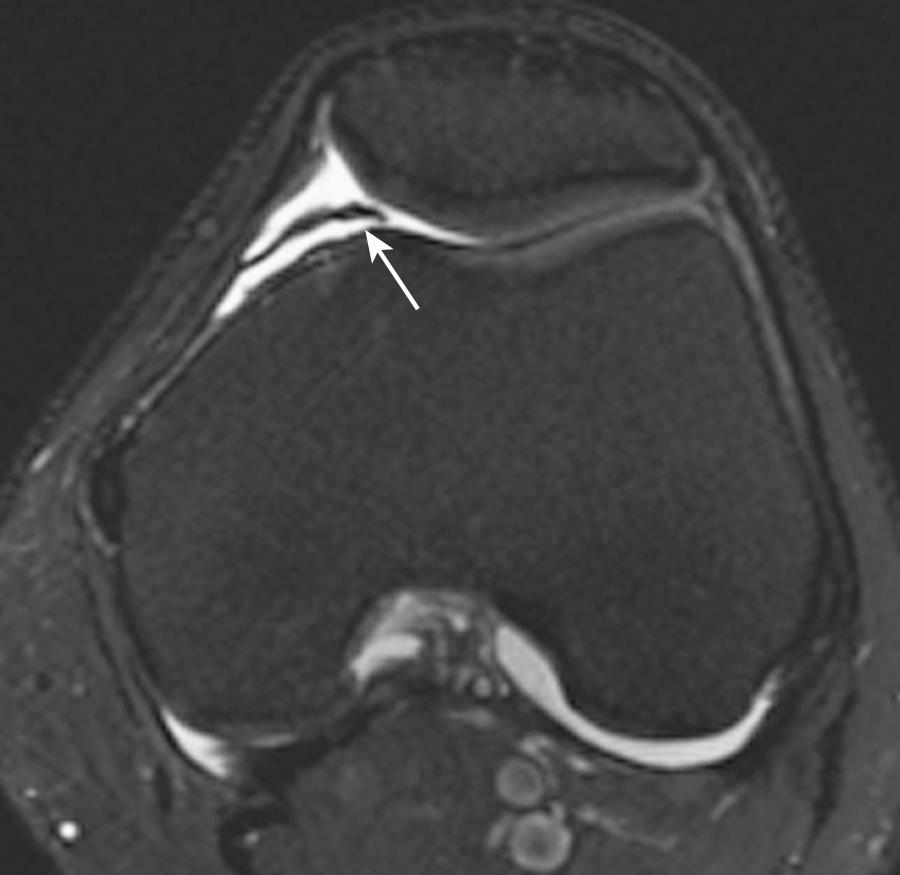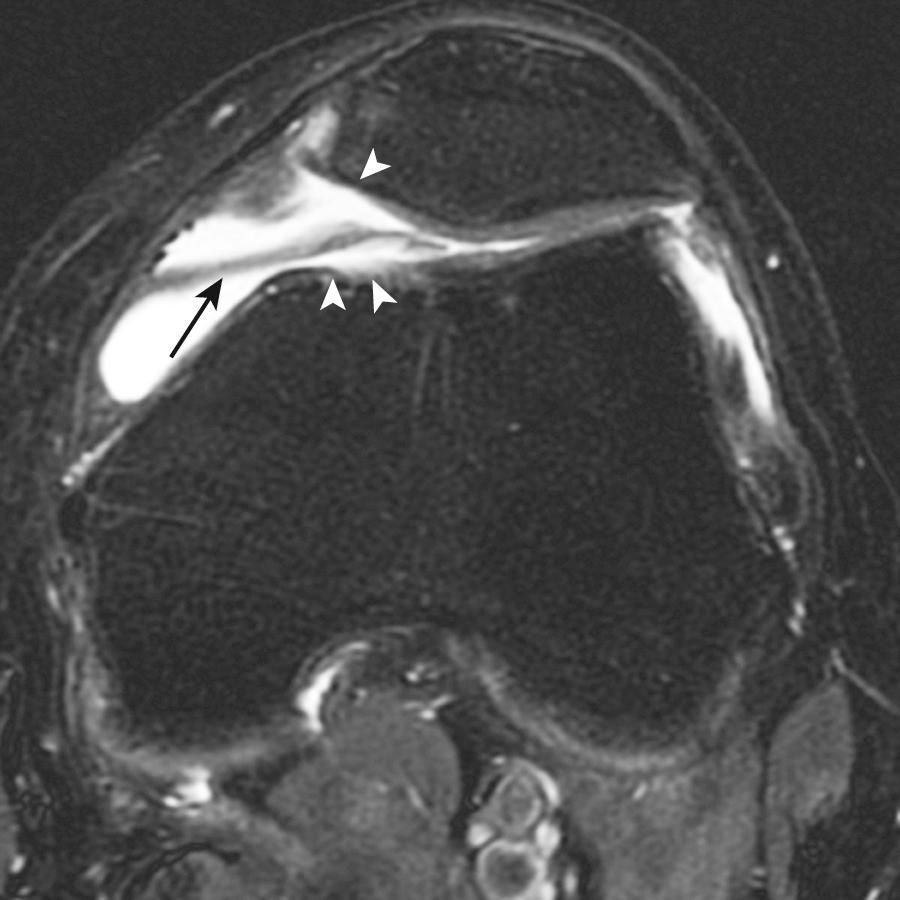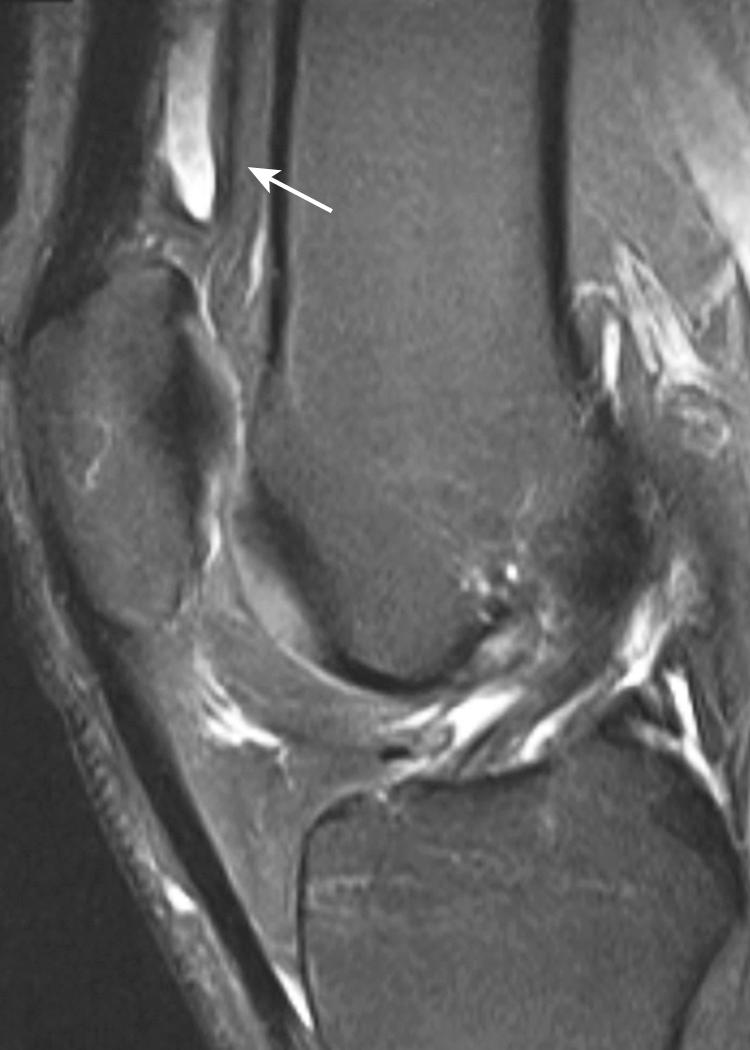Physical Address
304 North Cardinal St.
Dorchester Center, MA 02124
It is important for the surgeon to understand the principles for imaging the synovial compartments and articular cartilage of the knee. This chapter summarizes the anatomy, normal variations, pathologic conditions, and the strengths and weaknesses of the available imaging modalities.
The synovium surrounding a joint has an outer fibrous capsule and an inner thinner synovial membrane. The inner vascular synovial membrane lines the nonarticular portions of the synovial joint and the intra-articular ligaments and tendons. It secretes synovial fluid, which nourishes and helps lubricate the joint, and maintains joint integrity by assisting with removal of debris. Within the knee joint anteriorly, the synovial lining extends superior to the patella and deep to the quadriceps femoris to form the suprapatellar recess. Below the patella, the infrapatellar fat (Hoffa's fat pad) displaces the synovium posteriorly away from the patellar tendon toward the intercondylar notch. The synovium then extends posteriorly within the intercondylar notch covering the cruciate ligaments, which divides the knee into medial and lateral compartments with an interposed extrasynovial space containing the cruciate ligaments. A posterior recess at midline is identified posterior to the posterior cruciate ligament and is an extension from the medial tibiofemoral compartment. Other posterior recesses are seen between the posterior aspect of the femoral condyles and the deep surface of the lateral and medial heads of the gastrocnemius. Posterolaterally, the synovial membrane extends around the popliteus tendon at the popliteal hiatus, and extends inferiorly forming the popliteus bursa. The recesses are important when magnetic resonance imaging (MRI) is reviewed concerning important findings, such as intra-articular bodies and synovial disease, often present in these locations.
The normal synovium is barely perceptible on MRI and hence its visualization suggests the presence of synovial pathology. MRI and power Doppler ultrasound are the most sensitive imaging modalities to demonstrate abnormal synovium, but findings are usually nonspecific. Proliferative synovium exudes fluid and hence effusions are the most common and most sensitive finding of joint pathology. Synovial thickening and proliferation can be seen as complex or dirty fluid on T2-weighted images with careful windowing applied. Synovitis can be a diffuse or localized process. MRI with administration of intravenous gadolinium contrast shows the extent of synovitis more accurately because it provides strong, rapid enhancement; contrast can differentiate proliferative synovium from joint effusion. Power Doppler ultrasound can also demonstrate synovial inflammation quite effectively.
A plica is a fold of vascularized synovial tissue that is a remnant of cavitation junction formation during embryologic development. The most commonly seen plicae are the infrapatellar plica, the suprapatellar plica, and the medial patellar plica. They are usually asymptomatic and normally found in the knee, but any chronic inflammation may cause these plica to be symptomatic, with the medial patellar plica being the most common. At MRI, the plica appear as low-signal-intensity bands within the high-signal-intensity joint fluid on T2-weighted images ( Fig. 9.1 ). There are no size or morphologic criteria on MRI to determine whether a plica is clinically significant, although a symptomatic plica usually appears thickened with associated synovitis.

The suprapatellar plica divides the suprapatellar recess from the knee joint cavity. It courses obliquely downward from the anterior femoral metaphysis to the posterior aspect of the quadriceps tendon and inserts proximal to the superior pole of the patella. On MRI, it appears as a band-like low-signal-intensity structure posterior to the patella and is best seen on sagittal images.
The infrapatellar plica (ligamentum mucosum) is the most common plica in the knee. It has a dumbbell or fan-shaped appearance, originates from the intercondylar notch, and extends horizontally through the infrapatellar fat pad. On MRI, it is identified as a low-signal-intensity linear structure anterior and parallel to the anterior cruciate ligament (ACL) on sagittal images.
The medial patellar plica (plica alaris or patellar meniscus) is the most important clinically. It arises from the medial wall of the joint and courses obliquely, to insert on the infrapatellar fat pad. Sakakibara classified medial patellar plicae into four types on the basis of size: Type A is a cord-like elevation in the synovial wall, Type B has a shelf-like appearance that does not cover the anterior surface of the medial femoral condyle, Type C is large with a shelf-like appearance covering the anterior surface of the medial femoral condyle, and Type D is a plica with central fenestration. Types A and B are usually asymptomatic and an incidental finding in many patients, while types C and D can impinge between the medial femoral condyle and the patella, be symptomatic, and even occasionally cause cartilage loss at the femoral condyle and patella. Plica syndrome is defined as painful impairment of knee function, with a thickened fibrotic plica. It can be secondary to trauma, chronic repetitive activity, or other inflammatory process, and when the plica becomes thick and fibrotic, it causes friction over the medial femoral condyle and patella during knee flexion and extension ( Fig. 9.2 ). On MRI, the plica will appear thickened and irregular associated with a joint effusion.

Bursae are synovial-lined structures containing synovial fluid that function to facilitate movement and reduce friction where tendons and muscles pass over bony prominences. They are typically not visible on imaging because they contain limited fluid, however with inflammation, they become visible on MRI as fluid collections with low signal on T1-weighted images and high signal on T2-weighted images. They may or may not be communicating with the synovial membrane of the knee joint itself. Anteriorly, the suprapatellar recess is located between the quadriceps and femur in midline. It normally communicates with the knee joint, but failure of regression of the suprapatellar plica leads to obstruction of the recess. It may be found incidentally, or present as a mass above the knee joint when large ( Fig. 9.3 ). The prepatellar bursa is located anteriorly between the patella and the overlying subcutaneous soft tissues. Bursitis in that location is commonly caused by chronic repeated trauma such as kneeling (housemaid's knee). MRI shows a fluid signal intensity lesion in the subcutaneous soft tissues anterior to the patella. The superficial infrapatellar bursa is located between the tibial tubercle and the overlying skin and a bursitis is usually caused from chronic overuse. On MRI, it will appear as a focal localized fluid collection anterior to the patellar tendon. The deep infrapatellar bursa lies posterior to the distal patellar tendon and anterior tibia, and bursitis usually results from extensor mechanism overuse. On the medial aspect of the knee, the pes anserine bursa separates the pes anserine tendons (sartorius, gracilis, and semitendinosus tendons) from the adjacent medial tibial condyle. On MRI, it will appear as a high-signal-intensity fluid collection on T2-weighted images along the pes anserine tendons in the posteromedial aspect of the knee that does not communicate with the knee joint. The medial collateral ligament bursa is located between the superficial and deep layers of the medial collateral ligament at the level of the joint line. On the lateral aspect of the knee, the iliotibial band bursa is located between the distal portion of the iliotibial band near its insertion on Gerdy's tubercle and the adjacent tibial surface. On MRI, iliotibial band bursitis appears as a localized fluid collection between the distal iliotibial band insertion and the lateral aspect of the tibia.

Knee effusions are common and occur in a variety of settings (eg, trauma, degenerative, infection, or inflammatory conditions). On radiographs, knee effusions are only reliably seen on a lateral projection. A few signs have been described as sensitive for joint effusion including a rounded soft tissue density in the suprapatellar recess and loss of the normal posterior fat plane of the quadriceps tendon. A fat pad separation sign has been described that reflects the base of the suprapatellar bursa, which is located between the periarticular fat pads; a measurement greater than 10 mm is described as being diagnostic for an effusion. MRI is extremely sensitive to the presence of fluid. Although there is no consensus on when to call a joint effusion pathologic versus normal physiologic fluid, an anteroposterior measurement of 10 mm or less in the lateral aspect of the suprapatellar pouch is considered a reasonable threshold for distinguishing physiologic from pathologic fluid.
Hemarthrosis is most commonly seen after trauma, but is also observed in various arthropathies, bleeding disorders such as hemophilia, and tumor-like conditions such as synovial hemangioma and pigmented villonodular synovitis (PVNS). Layering will be seen in the acute setting with the serum above and cells below. The presence of a fat-fluid level indicates a lipo-hemarthrosis, which is considered a strong indicator for an intra-articular fracture. In the subacute phase, the effusion will be of relatively high signal on both the T1- and T2-weighted images. In the chronic phase, the synovium will show low signal on both T1- and T2-weighted images because of hemosiderin deposition and can show a blooming artifact (expansive black signal) on the gradient recalled echo (GRE) sequences.
Become a Clinical Tree membership for Full access and enjoy Unlimited articles
If you are a member. Log in here